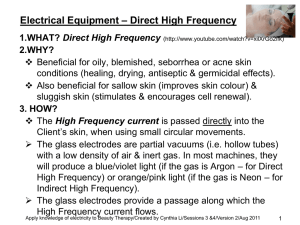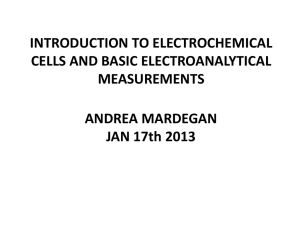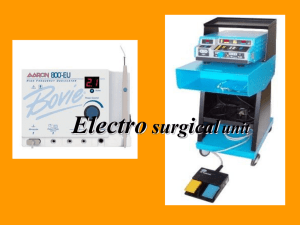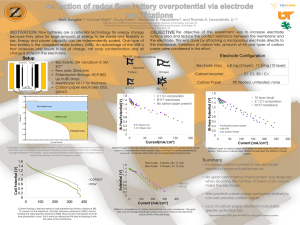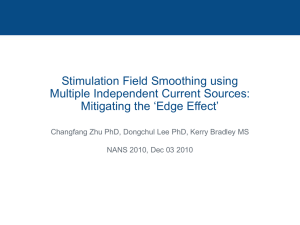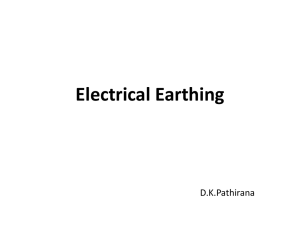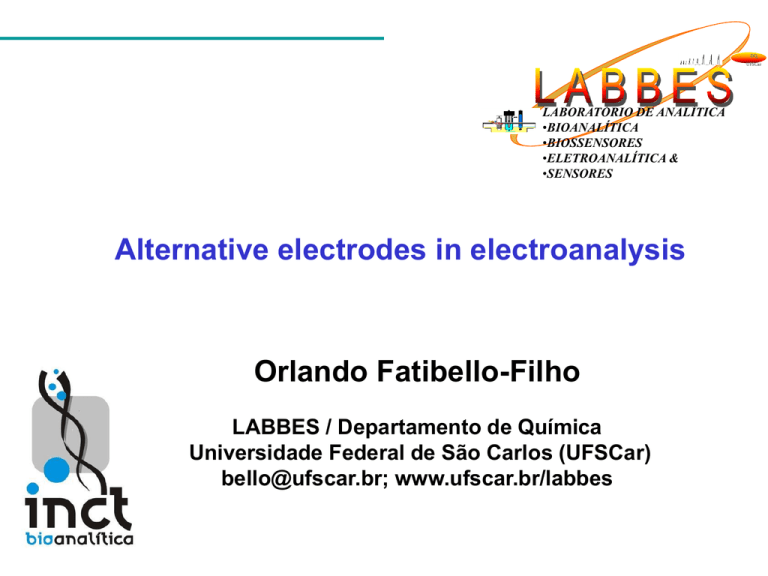
DQ
UFSCar
LABORATÓRIO DE ANALÍTICA
•BIOANALÍTICA
•BIOSSENSORES
•ELETROANALÍTICA &
•SENSORES
Alternative electrodes in electroanalysis
Orlando Fatibello-Filho
LABBES / Departamento de Química
Universidade Federal de São Carlos (UFSCar)
bello@ufscar.br; www.ufscar.br/labbes
São Carlos
SÃO CARLOS CITY
3
FEDERAL UNIVERSITY OF SÃO CARLOS
CHEMISTRY
DEPARTMENT OF CHEMISTRY
PVC electrodes
POTENTIOMETRICS
Metal-metal Oxide
electrodes
Biosensors
Composites electrodes
Amalgam electrodes
LABBES
Bismuth film electrodes
AMPEROMETRICS
/VOLTAMMETRICS
PIEZOELECTRICS
Carbon nanotubes,
carbon paste and carbon
composite electrodes
Boron-doped diamond
(BDD) electrode
Amorphous carbon
nitride (a-CNx) electrode
Biosensors
7
Introduction: Electroanalytical Methods
Advantages
Determination of analyte in colored solutions and/or with material
in suspension
In situ determination of analyte: portability of the instrument
Simultaneous determination of inorganic and/or organic analytes
Speciation of analyte
Disadvantages
Adsorption of substances in the electrode surface
Low stability of work electrode
low
reproducibility
Heyrovský`s article (1922)
Electrolysis with a Dropping
Mercury Cathode
J. Heyrovský, Chimické Listy, 16, 256 (1922)
Polarography
Fig. J. Heyrovsky, Masuzo Shikata and
the apparatus for measuring currentvoltage curves in electrolysis with
dropping mercury electrode (DME)
and a sensitive photographic paper)
J. Heyrovský, M. Shikata, Rec. Trav. Chim. Pays-Bas, 44, 496 (1925)
(C)
(A)
(B)
Fig. (A) Polarograph, (B) December 10th, 1959 received from the hands of
King of Sweden Gustav Adolph VI Nobel Prize for his invention of
polarography and (C) Nobel Prize Certificate
Characteristics of the dropping-mercury electrode (DME)
Advantages
High hydrogen overpotential
Good stability
Good reproducibility
Characteristics of noble metals (Au, Pt)
Disadvantages
O2 should be removed from solutions
Flow analysis
Use is limited in positive potentials
Toxicity
ISE 2010
Nice, France
Clarkson University, Potsdam, NY
Alternative electrodes in electroanalysis
Alternative electrodes in electroanalysis
Amalgam Electrodes for Electroanalysis
Fig. Dental and/or Amalgam Electrode
E. Mikkelsen, K.N. Schroder, Electroanalysis, 15(8), 679 (2003)
B. Yosypchuc, J. Barek, Crit. Rev. Anal. Chem., 39, 189 (2009)
D. de Souza, L. H. Mascaro, O. Fatibello-Filho, J. State. Electrochem., 15, 2023
(2011)
D. de Souza, L.C. Melo, A.N. Correa, P. Lima-Neto, O. Fatibello-Filho, L. H.
Mascaro, Quim. Nova, 34(3), 487 (2011)
C. M. A. Brett, F. Trandafir, J. Electroanal. Chem., 572(2), 347 (2004).
Classification of amalgam electrodes
Approximate potential ranges for platinum, mercury,
carbon, boron-doped diamond (BDD), amorphous
carbon nitride (a-CNx) and bismuth electrodes
-3.0
0
3.0 vs SCE
1M H2SO4
1M NaOH
Pt
1M H2SO4
1M KCl
Hg
1M NaOH
1M HClO4
0.1 M KCl
C
0.5 M H2SO4 BDD
0.5 M H2SO4 a-CNx
1M HClO4
0.5 M NaOH
Bi
Bismuth film electrodes
• Good negative potential window
• Interference of dissolved oxygen is minimal
• Low toxicity
• Electrochemical behavior is similar to that of mercury
L.C.S. Figueiredo-Filho, D.C. Azzi, B.C. Janegitz, O. Fatibello-Filho,
Electroanalysis, 24(2), 303 (2012)
L.C.S. Figueiredo-Filho, B.C. Janegitz, R.C. Faria, O. Fatibello-Filho, L. H.
Marcolino-Jr, F.R. Caetano, I.L de Mattos, Quim. Nova, 35(5), 1016 (2012)
L.C.S. Figueiredo-Filho, V.B. dos Santos, T.B. Guerreiro, O. Fatibello-Filho,
R.C. Faria, L.H. Marcolino-Jr, Electroanalysis, 22(11), 1260 (2010)
A. Caldeira,
C. Gouveia-Caridade,
R. Pauliukaite, Brett, C. M. A.,
Electroanalysis, 23(6), 1301 (2011)
Bismuth film electrode for in situ determinations
B
A
C
Bi
d e p o s it
=
C opper
p la te
3 -e le ctro d e s
sch e m e
In su la tin g
film
D e fin itio n
o f th e
su p e rficia l
a re a
Ag
d e p o s it
=
B i F ilm
m in i-se n so r
(A): PalmSens and (B): DropSens potentiostats and (C) BiSPE preparation
L. C. S. Figueiredo-Filho et al., Analytical Methods, 5, 202 (2013)
Bismuth film electrode for in situ determinations
TT-type
connector for
printers
Fig. A) electrochemical cell built with inexpensive materials and B)
set for analysis: connector, minisensor and electrochemical cell
(ink color container) for in situ determinations
L.C.S. Figueiredo-Filho, B.C. Janegitz, R.C. Faria, O. Fatibello-Filho, L. H.
Marcolino-Jr, F.R. Caetano, I.L. de Mattos, Quim. Nova, 35(5), 1016 (2012)
Bismuth film electrode for in situ determinations
A
B
C
Fig. FEG-SEM (Field emission gun scanning electron microscope)
micrographs of the bismuth film electrodeposited onto a copper
electrode: A) copper substrate, B) BiFE 15000 X and C) XRD (X-ray
Diffraction): Bi black and Cu (gray)
Bismuth film
-0.18 V vs. Ag/AgCl (3.0 mol L-1 KCl) during 200 s
0.02 mol L-1 Bi(NO3)3, 1.0 mol L-1 HCl in 0.15 mol L-1 sodium citrate
Bismuth film electrode (BiFE) for paraquat determination
H3C
N
N
CH3
e-
H3C
N
N
(PQ2+)
CH3
(PQ +)
E1 = -0.67 V vs. (Ag/AgCl) PQ1
H3C
N
N
(PQ +)
CH3
e-
H3C
N
N
CH3
(PQº)
E2 = -0.98 V vs. (Ag/AgCl) PQ2
Fig. DP voltammograms of paraquat (1,1'-dimethyl-4,4'-bipyridinium
dichloride) in 0.1 mol L-1 acetate buffer solution (pH 4.5)
L.C.S. Figueiredo-Filho, V.B. dos Santos, B.C. Janegitz, T.B. Guerreiro, O. FatibelloFilho, R.C. Faria, L.H. Marcolino-Jr, Electroanalysis, 22(11), 1260 (2010)
Bismuth film electrode (BiFE) for atrazine determination
Fig. Proposed mechanism for reduction of 2-chloro-4-(ethylamine)-6(isopropylamine)-s-triazine (ATZ)
L.C.S. Figueiredo, D.C. Azzi,
Electroanalysis, 24, 303 (2012)
B.C.
Janegitz,
O.
Fatibello-Filho,
Pb2+: 1.3 – 13.0 µmol L-1 , LD: 0.83 µmol L-1
Cd2+: 0.99 – 12 µmol L-1 , LD: 0.53 µmol L-1
Potentiostat
Determinação in situ e on-line analitos orgânicos e cátions metálicos
Instrumentação portátil (bateria), robusta, exata e precisa
Análises rápidas
Controle térmico
600
500
700
400
I / A
600
GPS
300
200
500
I / A
400
100
0
0.1
0.2
0.3
0.4
2+
0.5
-6
0.6
0.7
0.8
-1
[Pb ] / 10 mol L
300
200
100
Rede Wi-Fi
0
-0,7
-0,6
-0,5
-0,4
-0,3
-0,2
E / V Vs Ag
Uso de ferramentas de tecnologia da
informação (TI): Comunicação Wi-Fi,
Bluetooth, GPS, GSM, telefonia 3G
(SMS).
Carbon, carbon paste and carbon composite electrodes
(g)
Fig. Structures of (a) glassy carbon, (b) graphite, (c) carbon nanotubes,
(d) graphite powder, (e) carbon fibres, (f) boron-doped diamond, (g)
fullerene (h) graphene and (i) pyrolitic graphite (not shown)
E.T.G. Cavalheiro, C.M;.A. Brett,, A. M. Oliveira-Brett, O. Fatibello-Filho, Bioanal.
Rev, 4, 31 (2012); Pauliukaite, R., Ghica, M.E., Brett, C.M.A., Fatibello-Filho, O.,
Anal. Chem., 81, 5164 (2009); Ghica, M.E., Pauliukaite, R., Brett, C.M.A., FatibelloFilho, O., Sensors and Actuactors, 142, 308 (2009)
Single-walled carbon nanotubes (SWCNTs) and multi-walled carbon
nanotubes (MWCNTs)
A: 1-2 nm diameter
B: 2 to 100 nm separated by a
distance of 0.3-0.4 nm
Schematics of an individual (A) SWCNT and (B) MWCNT
Iijima, S., Nature, 354, 56 (1991); Merkoçi, A. et al. Trend Anal. Chem., 24, 826 (2005)
Carbon nanotubes
Good electrical conductivity and mechanical strength
Relatively chemically inert in most electrolyte solutions
High surface activity
Wide operational potential window
Insolubility of CNTs in all solvents
Wildgoose, G. G. et. al. Microchim. Acta, 152, 187 (2006); Banks, C. E. et al. Chem.
Commun., 829-841 (2005); Merkoçi, A. et al. Trend Anal. Chem., 24, 826 (2005).
Treatment of carbon nanotubes
Treatment of the carbon nanotubes increases the sensitivity
of the electrodes, because there is the appearance of reactive
groups such as -COO-,-OH, C=O and others
The literature reports several treatments, which use mainly
concentrated 2 mol/L HCl, H2O and conc. H2SO4/ HNO3 3:1 v/v
B.C. Janegitz, L.H. Marcolino-Junior, S.P. Campana-Filho, R.C. Faria, O.
Fatibello-Filho, Sens. Actuators B-Chem., 142, 260 (2009)
H.H. Takeda, B.C. Janegitz, R.A. Medeiros, L.H.C. Mattoso, O. FatibelloFilho, Sens. Actuators B-Chem., 161, 755 (2012)
Simultaneous Voltammetric Determination of Ascorbic Acid and Sulfite
in Beverages Employing a Glassy Carbon Electrode Modified with
Carbon Nanotubes within a Poly(Allylamine Hydrochloride) (PAH) Film
(PAH)
Fig. Cyclic voltammograms (50 mV s−1), after background
subtraction, of a (a) GCE and (b) MWCNTs-PAH/GCE for 250 µM AA
and a 450 µM sulfite in 0.1 M acetate buffer solution (pH 4.6).
E.R. Sartori, O. Fatibello-Filho, Electroanalysis, 24(3), 627 (2012).
Chitosan (linear -1,4-linked polysaccharide)
OH
O
HO
NH3
O
O
O
HO
NH3
n
OH
S o lu b le
OH
O
HO
NH2
O
+ 2n H+
O
O
HO
NH2
OH
In s o lu b le
Chemical equilibrium of chitosan in solution
Pauliukaite, R. ; Ghica, M. E. ; Fatibello-Filho, O. ; Brett C.M.A., Anal. Chem.,
81, 5364-5372 (2009)
Pauliukaite, R. ; Ghica, M. E. ; Fatibello-Filho, O. ; Brett C.M.A.
Electrochimica Acta, 55, 6239 (2010)
EDC-NHS
N
N
C
N
1-ethyl-3-(3-dimethylaminopropyl) carbodiimide (EDC)
O
HO
N
O
N-hydroxysuccinimide (NHS)
Possible mechanism of covalent binding of CNTs using Chit crosslinking
and EDC/NHS (1-ethyl-3-(3-dimethylaminopropyl) carbodiimide/Nhydroxysuccinimide)
Pauliukaite, R., Ghica, M.E., Brett, C.M.A., Fatibello-Filho, O., Anal. Chem.,
81, 5164 (2009)
Ghica, M.E., Pauliukaite, R., Brett, C.M.A., Fatibello-Filho, O., Sensors and
Actuactors, 142, 308 (2009)
O
O
O
OH
C
C
O
OH
n HO
N
O
C
C
O
NH
C
O
O
O
C
O
N
OH
N
H
N
O
C
C
HO
O
O
C
A
OH
O
O
C
N
H
N
H
N
O
N
C
C
B
O
HN
O
O
HO
OH
NH
HO
O
O
N
O
O
O
O
O
HO
NH
O
OH
NH
OH
O
O
C
O
HO
O
O
C
Scheme of possible ways of enzyme immobilization at the electrode
modified with chitosan and MWCNTs: (A) enzyme attachment directly to
CNTs by EDC-NHS and (B) enzyme linked to both chitosan and to CNTs
by EDC-NHS and GA.
Carbon paste electrodes
C. Vieira, O. Fatibello-Filho, Talanta, 52(4), 681 (2000)
M. F. S. Teixeira, A. Z. Pinto, O. Fatibello-Filho, Talanta, 45(2), 249 (1997)
B. C. Janegitz, L. C. S. Figueiredo-Filho, L. H. Marcolino-Jr, O. FatibelloFilho, J. Electroanal. Chemistry, 660(1), 209 (2011)
F. C. Vicentini, L.C.S. Figueiredo-Filho, B. C. Janegitz, A. Santiago, E.R.
Pereira, O. Fatibello-Filho, Quim. Nova, 34(5), 825 (2011)
Composite Electrodes
T. Navratil, J. Barek, Crit. Rev. Anal. Chem., 39, 131 (2009)
Composite electrode
Fig. Composite Electrode
C. M. F. Calixto, P. Cervini, E. T. G. Cavalheiro, Quim. Nova, 31(8), 2194 (2008)
I. Cesarino, C. Gouveia-Caridade, R. Pauliukeite, E. T. G. Cavalheiro, Brett, C.
M. A., Electroanalysis, 22(12), 1437 (2010)
I. Cesarino, E. T. G. Cavalheiro, Brett, C. M. A., Microchimica Acta, 171 (1-2), 1
2010)
Boron-doped diamond electrode
corrosion stable in very aggressive media
very low and stable background current
very low adsorption of organic/inorganic species
extreme electrochemical stability in both alkaline
and acid media
high response sensitivity
very wide working potential window (3.5 V)
K. Pecková et al. Critical Reviews in Analytical Chemistry. 39 (2009) 148
L.S. Andrade, G. R. Salazar-Banda, R. C. Rocha-Filho, O. Fatibello-Filho,
Cathodic Pretreatment of Boron-Doped Diamond Electrodes and Their Use
in Electroanalysis, In: Synthetic Diamond Films: Preparation,
Electrochemistry, Characterization, and Applications, (Eds. E. Brillas and
C. A. Martínez-Huitle), John Wiley & Sons, Inc., Hoboken, NJ, USA, 2011.
Experimental
Working electrode: Boron-doped diamond film (8000 ppm) on a
silicon wafer from Centre Suisse de Electronique
Microtechnique SA (CSEM), Neuchatêl, Switzerland
et
Electrochemical pre-treatments
Cathodic pretreatment: –1.0 A cm–2 for 180 s in a 0.5 M H2SO4
solution
Anodic pretreatment: +1.0 A cm-2 for 180 s in a 0.5 M H2SO4
solution
Counter electrode: Pt wire
Reference electrode: Ag/AgCl (3.0 M KCl)
Potentiostat/galvanostat: Autolab PGSTAT-30 (Ecochemie)
controlled with the GPES 4.0 software
de
Electrochemical pre-treatments
Characteristics of the procedure:
simple and rapid
low cost
good intra- and inter-day repeatabilities
Cathodic pre-treatment
Hydrogen-terminated BDD
(HT-BDD)
Anodic pre-treatment
Oxygen-terminated BDD
(OT-BDD)
G.R. Salazar-Banda, L.S. Andrade, P.A.P. Nascente, P.S. Pizani, R.C. RochaFilho, L.A. Avaca. Electrochimica Acta, 51, 4612 (2006)
Square-wave voltammetric determination of acetylsalicylic acid
in pharmaceutical formulations using a BDD electrode without
the need of previous alkaline hydrolysis step
Highlight:
first voltammetric
method in the
literature!
HTB: 2-(hydroxyl)-4-(trifluoromethyl)-benzoic acid
LOD = 2.0 M
E.R. Sartori, R.A. Medeiros, R.C. Rocha-Filho, O. Fatibello-Filho. J. Braz. Chem.
Soc., 20 360 (2009); T.A. Enache, O. Fatibello-Filho, A. M. Oliveira-Brett.
Combinatorial Chemistry & High Throughput Screening, 13, 569 (2010)
Paracetamol (A) and caffeine (B) in pharmaceuticals
Differential pulse voltammetry
Paracetamol: 0.50 – 83 M
LOD = 0.049 M
Caffeine: 0.50 – 83 M
LOD = 0.035 M
Highlight:LODs lower than those reported;
higher sensitivity and larger linear
concentration range of the analytical curve
17 M
38 M
B.C. Lourenção, R.A. Medeiros, R.C. Rocha-Filho, L.H. Mazo, O. Fatibello-Filho,
Talanta, 78, 748 (2009)
Repeatability study
50
70
45
40
GC
50
30
I/A
I/A
35
60
25
20
BDD
40
30
20
15
10
10
0.4
0.6
0.8
1.0
1.2
E/V vs Ag/AgCl
1.4
1.6
0
0.4
0.6
0.8
1.0
1.2
1.4
1.6
E/V vs Ag/AgCl
Repeatability study for 0.029 M Ascorbic acid + 0.79 M caffeine in
0.1 M H2SO4 (n = 10)
Highlight:
higher repeatability of the BDD
electrode
RSD = 8.7 % for glassy-carbon (GC) electrode
RSD = 1.0 % for boron-doped diamond (BDD) electrode
B.C. Lourenção; R.A. Medeiros; R.C. Rocha-Filho; O. Fatibello-Filho;
Electroanalysis, 22, 1717 (2010)
Simultaneous voltammetric determination of synthetic colorants
in food using a cathodically pretreated BDD electrode
SY
TT/SY
TT/SY
BB/SY
BB/SY
TT
BB
Fig. Chemical structures of the Tartrazine (TT), Sunset yellow (SY)
and Brilliant blue (BB) and DP voltammograms
LOD = 62.7, 13.1 and 143 nmol L-1 for TT, SY and BB, respectively.
R. A. Medeiros, B.C. Lourenção, R. C. Rocha-Filho, O. Fatibello-Filho, Talanta,
97, 291 (2012); R. A. Medeiros, B.C. Lourenção, R. C. Rocha-Filho, O.
Fatibello-Filho, Talanta, 99, 883 (2012)
Simultaneous Square-Wave Voltammetric Determination of
Phenolic Antioxidants (BHA and BHT) in Food Using a
Boron-Doped Diamond Electrode
OH
O
C (C H 3 ) 3
O
C (C H 3 ) 3
H 2O
OCH3
H 3O
C (C H 3 ) 3
+
2
e-
2H 2 O
C H 3O H
OCH3
H 3O
+
O
BHA
OH
O
C (C H 3 ) 3
(C H 3 ) 3 C
H 2O
CH3
C (C H 3 ) 3
(C H 3 ) 3 C
+
H 3O
+
2
e-
CH3
BHT
BHA = butylated hydroxyanisole; BHT = butylated hydroxytoluene
R.A. Medeiros, R.C. Rocha-Filho, O. Fatibello-Filho, Food Chemistry, 123 , 886 (2010)
OH
BHA
C (CH 3 ) 3
OCH3
OH
BHT
C (CH 3 ) 3
(C H 3 ) 3 C
CH3
BHA: 0.60 – 10 M; LOD = 0.14 M
BHT: 0.60 – 10 M; LOD = 0.25 M
Highlight:
LODs lower than those
previously reported
Potentiostat/galvanostat:
Autolab PGSTAT-30
(Ecochemie)
Flow Injection analysis system
Flow electrochemical cell
Working electrode :
BDD
8000 ppm; 0.33 cm2
Counter electrode :
stainless steel tube
Reference electrode
Ag/AgCl
(3.0 mol L–1 KCl)
E. M. Richter et al. Quim. Nova, 26(6), 839 (2003)
L. Andrade et al. Anal. Chim. Acta 654, 127 (2009)
Flow injection simultaneous determination of BHA and BHT
with multiple pulse amperometric detection at a BDD electrode
2,5
1,6
(A) - BHA
2,0
(B) - BHT
1,2
I/
1,5
I/
1,0
0,5
0,4
0,0
0,3
0,8
0,0
0,4 0,5 0,6 0,7 0,8 0,9
-1
E/V vs. Ag/AgCl (KCl 3,0 mol L )
1,0
0,7 0,8 0,9 1,0 1,1 1,2 1,3
-1
E/V vs. Ag/AgCl (KCl 3,0 mol L )
Fig. Hydrodynamic voltammograms obtained for (A) 0.10 mmol L-1 BHA and (B)
0.10 mmol L-1 BHT by use BDD; flow rate = 2.4 mL min-1 and Vsample = 250 µL
R.A. Medeiros; B.C. Lourenção; R.C. Rocha-Filho, O. Fatibello-Filho; Anal.
Chem.,82, 8658 (2010)
(A) MPA waveform applied to the cathodically pretreated BDD working electrode
as a function of time. (B) Flow-injection pulse amperometric responses in
triplicate for solutions containing 50 μmol L-1 BHA or BHT or both analytes
simultaneously at this concentration. Supporting electrolyte: aqueous ethanolic
(30% ethanol, v/v) 10 mmol L-1 KNO3 solution (pHcond =1.5) adjusted with
concentrated HNO3); flow rate 2.4 mL min-1; injected volume 250 μL.
FIA-MPA amperograms obtained after injections of solutions containing BHA
(0.050-3.0 μmol L-1) and BHT (0.70-70 μmol L-1) simultaneously or different
samples of mayonnaise (A-D). Supporting electrolyte: aqueous ethanolic (30%
ethanol, v/v) 10 mmol L-1 KNO3 solution (pHcond =1.5) adjusted with
concentrated HNO3); flow rate 2.4 mL min-1; injected volume 250 μL.
Sampling
Rate = 30 h-1
(A) Diagram of the multicommutated stop-flow system: V1 and V2: solenoid
valves;
A: sample or standard solution; C: carrier solution (BR buffer pH
7.0). (B) Transient DPV signals in triplicate for sulfamethoxazole (1.0 – 8.0 mg
L–1) and trimethoprim (0.2 – 1.6 mg L–1) determination in pharmaceuticals.
Tyr-AuNPs/BDD biosensor
(A)
(B)
(C)
Fig. (A) Schematic representation of Tyr-AuNPs/BDD biosensor
fabrication process and (B) SEM image of BDD and (C) BDD/AuNPs.
Electrodeposition potential = -0.4 V and electrodeposition time = 40 s.
B. C. Janegitz, R. A. Medeiros, R. C. Rocha-Filho, O. Fatibello-Filho, Diamond
and Rel. Mater., 25, 128 (2012); J.T. Matsushima, L.C.D. Santos, A.B. Couto, M.R.
Baldan, N.G. Ferreira, Quim. Nova, 35(1), 11 (2012)
Amorphous carbon nitride (a-CNx) electrode
0.8
a-CNx
I (mA)
0.4
0.0
-0.4
-1.0 -0.5 0.0 0.5 1.0 1.5
E (V) vs. Ag/AgCl
2.0
CV voltammograms (v = 50 mV s–1) for a-CNx electrode in
0.5 mol L–1 H2SO4 supporting electrolyte.
Lagrini et al. Electrochemistry Communications 6, 245 (2004)
R.A. Medeiros, R. de Matos, C. Debiemme-Chouvy, A. Pailleret, H. Cachet,
C. Deslouis, R. C. Rocha-Filho, O. Fatibello-Filho, Electrochemistry
Communications, 24. 61 (2012)
Electrochemical pretreatment
60
a-CNx as-received
a-CNx PTA
a-CNx PTC
E = 71 mV
E = 121 mV
I (A)
30
0
-30
E = 302 mV
-60
-90
-0.4 -0.2 0.0 0.2 0.4 0.6
E (V) vs. Ag/AgCl
0.8
Fig. CV voltammograms (ν = 50 mV s–1) for 1.0 x 10–3 mol L–1
[K3Fe(CN)6] in 0.5 mol L–1 KCl using the a-CNx film as-received and
after PTA and PTC.
Pretreatment conditions
Current density: 3 mA cm–2 for PTA; 3 mA cm–2 for PTC in a 0.1 mol L–1 KOH
Time: PTA: 180 s; PTC: 180 s
Fig. CV voltammograms (ν = 50 mV s–1) obtained for 0.5 mmol L–1
dopamine (black) and 1.0 mmol L–1 ascorbic acid (gray) in 0.1 mol L–1
HClO4 using an a-CNx electrode anodically (A) or catodically (B)
pretreated in 0.1 mol L–1 KOH
Conclusions and prospects
Dropping mercury electrode (DME) vs Alternative electrodes
Dental and/or Amalgam Electrode
Alloy electrodes: Sn-Bi; Pt-Ru, Pt-Pd, Pt-Rh, Pt-Ir, Pt-Au, Pd-Au, Cu-Au...
Bismuth film electrode, Antimony film electrode
Carbon, carbon paste and carbon composite electrodes:
Glassy carbon, Graphite, Pyrolitic graphite electrodes
carbon nanotubes
fullerene
boron-doped diamond (BDD)
carbon fibres
graphene amorphous carbon nitride (a-CNx)
63


